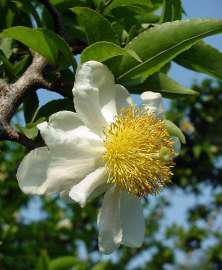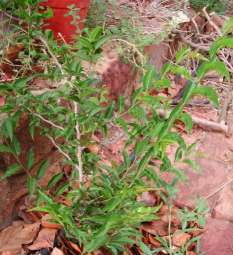Oncoba spinosa
Oncoba spinosa Forssk.
Family: Salicaceae
Common names: snuff-box tree (Eng.); snuifkalbassie (Afr.)
SA Tree No: 492
Introduction
This spiny shrub or small tree with pretty white flowers is known for the snuff boxes that can be made from its hard-shelled fruit.

Description
Description
The snuff-box tree grows up to 5 m, but may sometimes reach a height of 8 m. The bark of this plant is mottled grey and rather smooth. The young branches are conspicuously speckled with lenticels (a slightly raised, lens-shaped area on the surface of the young stems that helps with the exchange of gasses between the plant and the surrounding air). The spines are straight and up to 50 mm in length.

The leaves are simple, ovate-elliptic in form with a somewhat pointed tip and rounded, broad base. The leaves are dark, glossy green in colour and somewhat leathery and hairless. The margins are coarsely toothed.
It bears large (90 mm wide) showy, sweet-scented, white flowers with masses of yellow, overlapping stamens in the centre. Flowers somewhat resemble a fried egg and in Zimbabwe it is called the fried-egg flower. The flowers are bisexual and are borne at in the base of the leaves or at the end of the branches. It flowers from September to January. The ovary is one-chambered.

The rounded fruit of up to 60 mm in diameter, consists of a hard shell that becomes dark-reddish brown when mature and small, with shiny brown seeds embedded in a dry, sour, yellowish pulp. Fruit can be found on the tree from April to July.
Conservation Status
Status
Least Concern (LC).
Distribution and habitat
Distribution description
This tree occurs in the northeastern part of South Africa, primarily in Mpumalanga and further north along the Zambezi River. It is found over a large range of altitudes, from bushveld areas to riverine fringe forest.
Derivation of name and historical aspects
History
Oncoba is derived from the Arabic name for the North African species, Onkub. The species name spinosa refers to the spines. Spines are usually a modification of a leaf or stipule, a small scale or leaf like appendage at the base of the leaf stalk.
Uses
Use
The pulp of the fruit is edible, but is seldom used for that purpose. In African medicine the roots are used in the treatment of dysentery and bladder complaints. The hard-shelled fruits are used as snuff boxes. If the fruit are left to dry with the seeds inside they it make amusing rattles for children and are also used as anklets and armlets for dancers to add rhythm when performing.
It is said that the seeds contain a drying oil that is suitable for varnish, but it is too difficult to extract to be of any commercial significance. The wood is light brown in colour and can take a good polish, but the pieces are seldom large enough to be of any commercial value.
Growing Oncoba spinosa
Grow
Cultivation is not difficult and fresh seeds, collected from the tree, can be pushed into river sand flush with the surface and kept moist. Initial growth is slow but will speed up after 9 to 12 months. It can grow up to 500 mm per year in the Highveld region and even up to 1 m in areas with a high rainfall. It is a protected tree in South Africa.
References
- Germishuizen, G., Meyer, N.L., Steenkamp, Y. & Keith, M. (eds) 2006. A Checklist of South African plants. Southern African Botanical Diversity Network Report No. 41. SABONET, Pretoria.
- Coates Palgrave, K. 1990. Trees of southern Africa. Struik, Cape Town.
- Van Wyk, B. & Van Wyk, P. 1997. Field guide to trees of southern Africa . Struik, Cape Town.
- Van Wyk, P. 1990. Veldgids tot die bome van die Nasionale Krugerwildtuin . Struik, Cape Town.
Credits
Karin Behr
Pretoria National Botanical Garden
November 2004
Plant Attributes:
Plant Type: Shrub, Tree
SA Distribution: KwaZulu-Natal, Limpopo, Mpumalanga
Soil type: Sandy, Loam
Flowering season: Spring, Early Summer
PH: Acid, Neutral
Flower colour: White, Yellow
Aspect: Full Sun
Gardening skill: Average
Special Features:
Horticultural zones











Rate this article
Article well written and informative
Rate this plant
Is this an interesting plant?
User Comments
Liesel Kaumpek, South Africa
October 28, 2019 at 11:15 PMMy Ocnobia spinosa seems to be struggling. They are in a very hot sunny spot...will it help to water them more frequently or to bury a plastic bottle with a small whole so that the constantly get a small drip of water to their roots?
Login to add your Comment
Back to topNot registered yet? Click here to register.